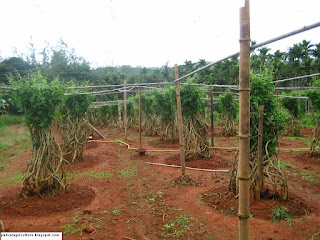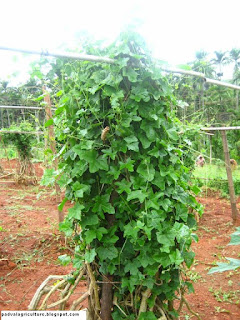
Coccinia indica is a well known vegetable grown in the coastal which is high in nutritive value. the ripe fruit which is red in color is a well known anti diabetic & is being exported to many countries for this purpose.
LAND PREPARATION
summer crop
since the plant is a long vine, it has to be trained over a trellis. the land selected must be free from all weeds & big stones. pits around 1 meter wide & up to 2 or 3 feet deep are dug. 2 to 3 baskets of organic manure are added to each pit & the soil is mixed well so that the manure added is evenly mixed in the soil.
healthy stumps of the coccinia plant are chosen, & a pointed cut is given to the base of the stump for polarity. the selected stumps must be dipped in a solution containing 2 gram per litre carbofuran granules. this is done to prevent the soil pathogens, nematodes from attacking the stumps.
in each pit 4 stumps must be planted preferably at the corners of the pit & soil added. top part of the stumps must be supported by rope or nylon thread & tied to the trellis.

the trellis must have adequate height or plucking the fruit becomes cumbersome. stone poles, bamboo can be used as pillars while light weight bamboo, plastic pipes of thin guage etc can be used as the canopy. nylon thread, has to be tied & from one end of the stone pillars to the other end in a net like formation. the developing long vines will be trained over this.

the above pic shows nylon ropes being used

for the frame of the trellis, strong metal pipes can be used & light weight plastic pipes can be used in the middle as the pic shown above indicates.
 the above pic shows the height which is a key factor in plucking. other interculture operations like top dressing, earthing up & watering becomes easy when the trellis has good height.
the above pic shows the height which is a key factor in plucking. other interculture operations like top dressing, earthing up & watering becomes easy when the trellis has good height.MANURING
since the vines grow to several meters, & produce many offshoots, fertilizer management has to be monitered regularly.
it is highly recommended to apply 2 baskets of fresh organic manure to every pit, every month along with 100 to 200 gram NPK.

the above photo shows the application of bacterial culture along with compost manure slurry.
in a 100 litre water drum, add 1 basket of fresh organic manure. add bacterial gel @ 2 kg per 100 litres water. one can also add solution of decompising bacteria as this will help release nutrients faster to the plant.


rainy season crop
cultivation of the crop during rain is very challenging as the plant is highly intolerant to excess rainfall. pollination does not occur as the pollen grains are washed away. also the plant is highly succeptable to many fungal infections. other insect pathogens take cover in the thick vegetative foliage & further damage the plant.
here water logging at the bases of the pits should be checked. as a preventive, the pits must be covered with soil so as to get a heap. & all weeds around the heap must be removed.
 the above photo shows the change in the pits. soil is heaped & excess water is made to run off the sides of the heap.
the above photo shows the change in the pits. soil is heaped & excess water is made to run off the sides of the heap.PRUNING
the most important in cultivation of coccinia is the timing of pruning the vines. repeated prunings are recommended as the newly developing vines produce more flowers & yield more. pruning the vines must be done every 3 to 4 months to maximise yield.

when the vines start to look a bit weak, & there is a change in color of the leaves to yellow, pruning is done. also close spacing of the stumps and planting more stumps in each pit, will result in overcrowding of the vines & harvesting is affected. in such cases the vines provide shelter to several insect pathogens which damage the main crop or other crops.

the above photo shows coccinia fruit severly attacked with aphids & thrips. Dimethoate@ 2 ml per litre or imidochloprid@ 1 ml per litre effectively control this problem. spraying of the crops is generally done during the evenings after 4 pm as early morning sprays are generally avoided as it may interfere with pollination by bees & other pollinators.
WATERING
summer
requires good quantity of water, but cannot tolerate stagnation. during fertilizer application every month, earthing up of the soil is done to break the clods & crust formation. earthing up of soil also increases the porosity & hence facilitates good drainage of water. mulching the pits is done to minimise watering. paddy straw, dried weeds, husk etc can be used as mulch.
it is recommended to water the crop at the time of plucking the fruit. mornings and evenings when the sun is not harsh is a good time to water the crop. watering thrice weekly in conditions when soil temperature is high is also practised.
monsoons
watering is not done during rainfall, however in green house conditions, it is recommended to water the crop at least once in 10 days.
heaping of the soil around the base of the stumps is done to prevent stagnation of water.
 the above photo shows the pruned stump which is supported to the trellis with ropes & nylon thread, while the base is supported by heaping the soil around it.
the above photo shows the pruned stump which is supported to the trellis with ropes & nylon thread, while the base is supported by heaping the soil around it.
the above photo shows newly developing vines, seen around 2 to 3 weeks after pruning & heaping the soil at the base of the stump.

the above photo shows the development of the vines after 4 weeks of pruning.

the vines have to be carefully monitored & seen that they do not fall in a downward direction. they have to be trained over the trellis and in a few weeks time covers the entire trellis like a green tent.
GREEN HOUSE/PLASTIC SHADE
excess moisture which is detrimental in the production of the fruit can be checked by raising make shift green houses. plastic sheets can be used and the entire plant must be covered.

notice the plastic sheet which is used in the above photo, the vines are kept dry, & the slight increase in temperature under the sheets is conducive for flowering & pollination.

the above photo shows the developing vines covering the entire trellis giving an appearance of a green carpet.

the above photo shows the formation of fruit, which is similar to the fruits formed in summer season. the main advantage of this method of cultivation in the monsoons is good price for the produce. shortage in production , during monsoons can be checked this way.
however the main disadvantage is, its a highly expensive & labour orientated. larger trellis areas need more plastic sheets & can be used for only one season due to wear and tear & thus is not cost effective. higher quality plastic sheets which can be re used up to 3 years are too expensive & might not cover the cost.
INTERCROPPING
Since periodic prunnings are done, the space between the pits can be utilized effectively to grow crops like cowpea, amaranth which does not take up much space to cultivate.

the above photo shows cowpea, bush type variety successfully grown between the rows of coccinia pits.
 this method can be practised in summer effectively. above photo shows, weeds being removed & heaping of the pits.
this method can be practised in summer effectively. above photo shows, weeds being removed & heaping of the pits.
Rich harvest above
 green carpet appearance of a typical coccinia trellis
green carpet appearance of a typical coccinia trellisPhotos and content by Pritham 'Heavy metal farmer' denzil dsouza
u r an absolute genious man...i am indeed very proud of u!!!
ReplyDeleteA word on pests and deceases would be much appreciated
ReplyDeletethanks Capt. Kavalil for checking my blog, coccinia or little gourd belongs to the same family of cucurbits like ash gourds, ridgel, bottle, snake, pumpkins etc and so the insect pests and other diesases are very similar in nature. if u have any problems , u could send me a brief description of the insect attack or disease on your crop and i will suggest solutions. i have not updated my blog, coz i have been extremely busy with farm work and still have over 300 photos and new posts still pending..and once i get the time, will update them asap. thank you
ReplyDeletehello!i want to start coccinia in my farm land and want to know that where can i get good healthy stumps. thanks
ReplyDeleteu can contact me during the rainy season i could give u a lot of coccinia stumps.... apart from that i really dont know if anyone sells them
ReplyDeleteHi Pritham,
ReplyDeleteWe produce tissue culture Tindora (Coccinia indica) and have been supplying it in Gujarat since the last 3 years. The farmers here get good yields of about 40 MT per annum per acre. I'd like to buy your stumps, because we can't get enough elite material! We also produce tissue culture Parval (Tricosanthes diocia)
How do I get in touch with you? Pl call me on 0787 406 5060
Can I just say- your blog is mind blowing!!! Hopefully some day I'll get to visit?